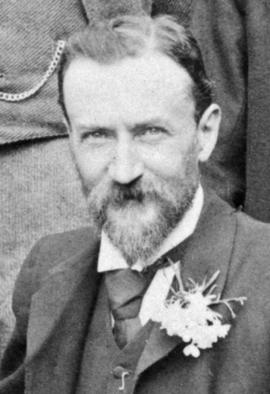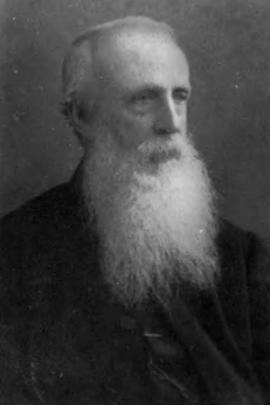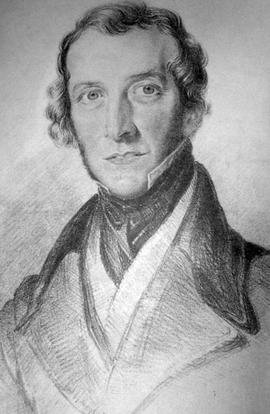Arthur Gardiner Butler was an English entomologist, arachnologist and ornithologist. He worked at the British Museum on the taxonomy of birds, insects and spiders. He was also appointed assistant librarian at the British Museum in 1879
Octavius Pickard-Cambridge was an English clergyman and zoologist. His main interest was in spiders, though he wrote also on birds and lepidoptera. He published extensively on spiders between 1859 and his death in 1917, including in the the journal of the Zoological Society of London. He became a world authority of spiders, describing a considerable number of new species including the Costa Rican redleg tarantula and the Sydney funnel-web spider
Evelyn Cheesman was a British entomologist and traveller. Between 1924 and 1952, Cheesman went on 8 solo expeditions in the South Pacific, and collected over 70,000 specimens, which she accompanied with sketches and notes. These are now part of the collections of the Natural History Museum.
Cheesman was one of five children of Florence Maud Tassell and Robert Cheesman, born 8 October 1882. Interested in the natural world, Cheesman was unable to train for a career as a veterinary surgeon because the Royal Veterinary College did not accept women students in 1906.
After World War I, she met Harold Maxwell-Lefroy, professor of entomology at Imperial College of Science and honorary curator of the insect house at Zoological Society of London, and studied entomology. In May 1917, Evelyn took up the position of Assistant Curator of Insects at London Zoo. In 1919 she became a fellow of the Royal Entomological Society of London. In 1920 she was the first woman employed as a curator at London Zoo.
In 1924 she was invited to join the St George zoological expedition to the Marquesas and Galapagos Islands as entomologist, alongside Anglo-Irish explorer and entomologist Cynthia Longfield. Cheesman considered the expedition to be disorganised, and left it at Tahiti. She was able to continue exploring and gathering specimens on her own with the help of £100 from her brother Bob. From then on, Cheesman preferred to travel alone.
In 1926, she resigned as Insect Curator and affiliated herself, unpaid, with the natural history department of the British Museum (now the Natural History Museum). She spent most of the next twelve years on expeditions, travelling to New Guinea, the New Hebrides and other islands in the Pacific Ocean. In New Guinea she made a collecting expedition to the coastal area between Aitape and Jayapura and visited the nearby Cyclop Mountains. She was known in the islands as 'the woman who walks' and 'the lady of the mountains'.
During the Second World War she returned to England and did war work, but injured her back. After the war, in 1949-50, she travelled to the Pacific islands again, but due to ongoing pain, decided to give up active exploration. She assisted at the Natural History Museum for many years as an unpaid volunteer. In 1954, after hip replacement surgery, at the age of seventy-three, she felt well enough to again go on an expedition to Aneityum in the South Pacific. She had a house, named 'Red Crest', built for herself about five kilometres inland from Alelgauhat village. During her nine-month stay she collected 10,000 insects and 500 plants.
She was made an Officer of the Order of the British Empire (OBE) in the 1955 New Year Honours, and was granted a civil list pension in the same year for her contributions to entomology. She continued to work at the museum, writing and classifying specimens, until her death in London on 15 April 1969.
Zakaria Erzinçlioğlu was a forensic entomologist. He used his expertise in insect biology in criminal investigations and solved more than 200 murders.
He was born in Hungary to parents of Turkish origin. He was brought up in Egypt, Sudan and England. He earned a degree in applied zoology from Wolverhampton Polytechnic in 1975, and then began working for the Zoological Society of London as Compiler for the Zoological Record. He then studied for his doctorate at Durham University. In 1984 he moved to Cambridge University where he wrote about blowflies for The Naturalists' Handbook series, as well as writing for other publications. He received funding to do research in forensic entomology and later was appointed director of a new Forensic Research Center at Durham University.
Thomas de Grey, 6th Baron Walsingham, was an English politician and amateur entomologist. He was a keen lepidopterist, collecting butterflies and moths from a young age, and was particularly interested in Microlepidoptera. After his purchase of the Zeller, Hofmann and Christoph collections, his collection contained over 260,000 specimens. He donated it to the Natural History Museum, along with his library of 2,600 books. He was elected a fellow of the Royal Society in 1887, and was a member of the Entomological Society of London, serving as President on two occasions
Arthur Grote was an English colonial administrator. He entered the Bengal Civil Service in 1834, where as a civil servant he was employed in Bengal from 1834 to 1868 and was commissioner and member of the Board of Revenue, Calcutta, 1861-8. He also served as President of the Asiatic Society of Bengal, 1859-62 and 1865, and President of the Royal Agricultural Society of India. On his return to England in 1868 he became a prominent member of the Linnean Society of London and Royal Asiatic Society, and wrote many papers on natural history subjects
Professor Edward Hindle was a British biologist and entomologist who was Regius Professor of Zoology at the University of Glasgow from 1935 to 1943. He specialised in the study of parasites. He was founder of the Zoological Society of Glasgow. In 1943 he was appointed the first Scientific Director of the Zoological Society of London
Frederick William Hope was an English clergyman, naturalist, collector and entomologist, who founded a professorship at the University of Oxford to which he gave his entire collection of insects in 1849 (the Hope Entomological Collections, with around 3.5 million specimens). He described numerous species and was a founder of the Entomological Society of London in 1833. He was a founder members of the Zoological Society of London. Hope collaborated with many naturalists of the period, including Charles Darwin
Harold Maxwell-Lefroy was an English entomologist. He served as a Professor of Entomology at Imperial College London and as the second Imperial Entomologist to India. He left India after the death of two of his children from insect-borne diseases. He worked on applied entomology and initiated experiments on the use of chemicals to control insects. A formula he developed was utilised to save Westminster Hall from destruction by wood-boring beetles, while others were used to control lice in the trenches during the First World War. The success of his chemicals led to increased demand and the founding of Rentokil, a company for insecticide production. Maxwell-Lefroy's students included Evelyn Cheesman who took up a position at the insect house in London Zoo from 1919. He was killed while experimenting on fumigants to control insects.
Andrew Dickson Murrary was a Scottish lawyer, botanist, zoologist and entomologist. Murray studied insects which caused crop damage, specialising in coleoptera. In botany, he specialised in Coniferae. He served as president of the Royal Physical Society of Edinburgh during 1858-59. Murray was a prominent opponent of the Darwin-Wallace model of natural selection. Murray believed that hybridisation was a better explanation for mimicry than natural selection. In 1860, Murray reviewed Darwin's On the Origin of Species in the Proceedings of the Royal Society of Edinburgh



